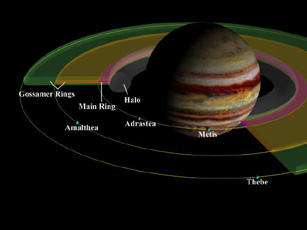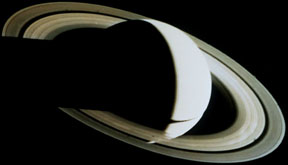Galileo Cruises the Inner Jovian System
On November 5, 2002, the Galileo spacecraft made one final close flyby of the innermost regions of Jupiter's system. Galileo, which has orbited Jupiter since 1995, took one final plunge deep into the heart of the Jovian system, where radiation levels could kill a human in minutes. The spacecraft will intentionally crash into Jupiter on September 21, 2003, to ensure that it cannot accidentally collide with Jupiter's moon Europa at some future date. Europa is one of the prime candidates for life beyond Earth within our Solar System, so scientists want to make certain that microbes onboard Galileo could never contaminate Europa. Galileo had never ventured so close to Jupiter before the November 2002 encounter. Radiation close to Jupiter could severely damage the robotic spacecraft's systems, so Galileo had been kept at a safer distance on earlier passes. Since scientists knew the craft's days were numbered, they decided to risk a closer flyby to gain the opportunity to directly measure aspects of the space near Jupiter.
The animation below portrays some of the information Galileo gathered on the November 2002 encounter (known to Galileo mission team members as the the "A34 pass" because it was Galileo's 34th orbit and the main target was the moon Amalthea). To view the animation, you will need to have the latest version of the Flash player installed on your web browser. Details about the features shown in the animation are described below.
The animation shows the area close to Jupiter. Jupiter has moons; the five closest to the planet (Adrastea, Metis, Amalthea, Thebe, and Io) are shown here. Jupiter also has a series of rings, like the famous rings of Saturn. Jupiter's rings are much fainter and smaller than are Saturn's. Saturn's rings are mostly ice, while Jupiter's are made of dust. Jupiter has three major rings. The Main Ring is very narrow and thin. It begins at a distance of 122,800 km from the center of Jupiter (Jupiter's radius is a whopping 71,398 km, so the ring is about 50,000 km above Jupiter's cloud tops). The Halo Ring is even closer to Jupiter, and is a larger, diffuse cloud of particles. Outside the Main Ring is the wispy Gossamer Ring, which extends to a distance well beyond 200,000 km from the center of Jupiter. The material in the rings is fine dust hurled up from the surfaces of Jupiter's inner moons by meteor impacts. Data from Galileo led scientists to discover the source of the ring material! The Gossamer Ring is further subdivided into the Thebe Gossamer Ring (further out) and the Amalthea Gossamer Ring (closer in). The two Gossamer Rings are named for the two small moons from which the material in each ring comes - Thebe and Amalthea.
Although it is nearly invisible, the dust of Jupiter's rings fills much of the space near the giant planet. There are other, even less visible, features near Jupiter that Galileo's instruments helped us detect. The space near Jupiter is seething with powerful magnetic fields, intense storms of radiation, and swarms of energetic particles.
Galileo Data
Three types of data are shown in the animation: radiation, energy, and electron density. The radiation values represent the general background radiation levels, and are expressed in units of counts. These radiation values are not directly expressions of data from Galileo's instruments; instead, they are values generated by a model that is based, in part, on data from Pioneer 11 (the last time a spacecraft penetrated deep into the radiation belts of Jupiter). Notice how the radiation values rise dramatically as Galileo gets close to Jupiter. The type of radiation depicted here is bombardment by electrons.
The energy values are measurements from an instrument designed to register counts per second of sulfur ions in the energy range of 16-30 keV per nucleon. The atmosphere of Io is mostly composed of sulfur compounds spewed into the atmosphere by Io's many volcanoes. These sulfur compounds are gradually torn from the top of Io's atmosphere in a process called 'sputtering', thus entering the general space around Jupiter. This high energy environment pulls the individual atoms in the sulfur compounds apart, then rips some of the electrons from the sulfur atoms, producing electrically charged sulfur ions. These charged ions are then subject to the forces of Jupiter's powerful magnetic fields, which accelerates them to high speeds and energy levels. The energy values shown in the animation are counts of sulfur ions in a specific energy range, 16 to 30 keV per sulfur ion. An electron volt (eV) is an energy unit used by particle physicists; a keV is one thousand electron volts (kilo-eV). Galileo's Energetic Particle Detector (EPD) measured counts of many types of ions in several different energy ranges, only one of which is displayed in this animation. Scientists are uncertain whether some of the readings of the EPD accurately depict ion counts; the detector may have been swamped by the swarms of energetic electrons found near Jupiter, causing it to register misleading readings.
The third value shown is electron density. It is expressed in terms of electrons per cubic centimeter. Remember the electrons that were ripped from the sulfur ions? That is one of many sources of free electrons in the space around Jupiter. Since electrons are also electrically charged, Jupiter's magnetic field accelerates them to high speeds and energies as well. Many of the electrons striking Galileo were traveling close to the speed of light! Notice how the electron density is high near the moon Io, and drops off suddenly at a point slightly inside the orbit of Io. Io's orbit is surrounded by two regions filled with energetic particles. They are the Io Warm Torus and the Io Cold Torus. The dropoff in electron density slightly inside the orbit of Io marks the boundary where the Warm Torus gives way to the Cold Torus.












